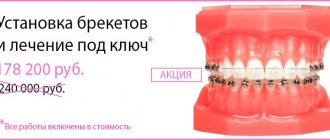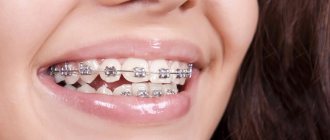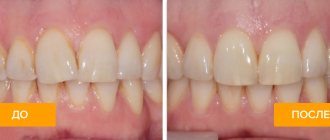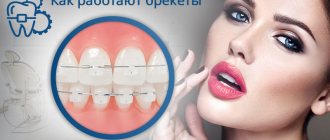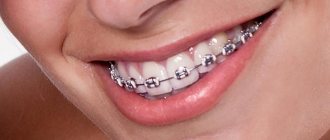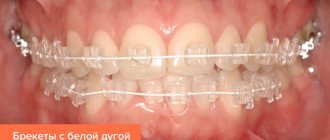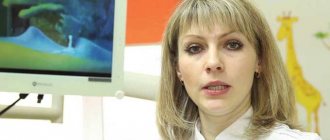How to install braces?
It is impossible to make recommendations remotely and decide which option is better. We offer you a wide range of dental braces, including both classic and innovative designs that are invisible on the teeth. If you decide to get braces, we recommend that you familiarize yourself with the specifications of the various models in more detail. Studying the types of braces and the materials used to make them will allow you to make the best choice.
Braces for the upper and lower teeth
Braces for one row of teeth
Cost of installing braces
| ORD-01 | Course of treatment using a brace system (for the upper and lower dentition): | |
| ORD-1.01 | Treatment with a metal brace system. I degree of severity | 113,000.00 ₽ |
| ORD-1.02 | Treatment with a metal brace system. II degree of severity | 158,200.00 ₽ |
| ORD-1.03 | Treatment with a metal brace system. III degree of severity | 158,200.00 ₽ |
| ORD-1.04 | Aesthetic bracket system: I degree of severity | 70,000.00 ₽ |
| ORD-1.05 | Aesthetic bracket system: II degree of severity | 80,000.00 ₽ |
| ORD-1.06 | Aesthetic bracket system: III degree of severity | 90,000.00 ₽ |
| ORD-1.07 | Self-ligating metal bracket system: I degree of severity | 70,000.00 ₽ |
| ORD-1.08 | Self-ligating metal bracket system: II degree of severity | 80,000.00 ₽ |
| ORD-1.09 | Self-ligating metal bracket system: III degree of severity | 90,000.00 ₽ |
| ORD-1.10 | Self-ligating aesthetic bracket system: I degree of severity | 80,000.00 ₽ |
| ORD-1.11 | Self-ligating aesthetic bracket system: II degree of severity | 90,000.00 ₽ |
| ORD-1.12 | Self-ligating aesthetic bracket system: III degree of severity | 100,000.00 ₽ |
| ORD-1.13 | Lingual braces: Children and teenagers | 90,000.00 ₽ |
| ORD-1.14 | Lingual braces: Adults | 110,000.00 ₽ |
| ORD-1.15 | Technique 2*41 dentition | 33,900.00 ₽ |
| ORD-1.16 | Preparation before orthopedics 1st quadrant | 22,600 ₽ |
| ORD-1.17 | Treatment with a ceramic bracket system. 1st degree of severity | 124,300 ₽ |
| ORD-1.18 | Treatment with a ceramic brace system. 2nd degree of severity | 146,900.00 ₽ |
| ORD-1.19 | Treatment with a ceramic brace system. 3rd degree of severity | 169,500.00 ₽ |
| ORD-1.20 | Treatment with a lingual brace system. 1st degree of severity | 135,600.00 ₽ |
| ORD-1.21 | Treatment with a lingual brace system. 2nd degree of severity. | 158,200.00 ₽ |
| ORD-1.22 | Treatment with a lingual brace system. 3rd degree of severity | 180,800.00 ₽ |
| ORD-1.23 | Observation, activation of the orthodontic apparatus | 1,000.00 ₽ |
| ORD-1.24 | Observation, activation of the orthodontic apparatus | 5,500.00 ₽ |
| ORD-1.25 | Fixation of the braces system on 1 row of teeth. | 15,000.00 ₽ |
| ORD-1.26 | Fixation of 1 metal bracket | 2,260.00 ₽ |
| ORD-1.27 | Fixation of 1 ceramic bracket | 2,830.00 ₽ |
| ORD-1.28 | Fixation of 1 lingual bracket | 3,390.00 ₽ |
| ORD-1.29 | Fixation of the buccal tube | 2,830 ₽ |
| ORD-1.30 | Bracket re-attachment/reposition | 900.00 ₽ |
| ORD-1.31 | Fixation of the orthodontic ring | 2,260.00 ₽ |
| ORD-1.32 | Re-fixation of the orthodontic ring | 570.00 ₽ |
| ORD-1.33 | Fixing the orthodontic button | 1,130.00 ₽ |
| ORD-1.34 | Fitting and applying a metal arc. | 2,260.00 ₽ |
| ORD-1.35 | Fitting and applying an aesthetic arch. | 3,390.00 ₽ |
| ORD-1.36 | Fitting and applying the reversal arc. | 2,830.00 ₽ |
| ORD-1.37 | Making and fixing a palatal clasp. | 5,650.00 ₽ |
| ORD-1.38 | Changing ligatures on 1 row of teeth. | 1,130.00 ₽ |
| ORD-1.39 | Fixation of 1 link of the elastic chain (chain) | 110.00 ₽ |
| ORD-1.40 | Fixation of open/closed spring. | 570.00 ₽ |
| ORD-1.41 | Spring activation. | 230.00 ₽ |
| ORD-1.42 | Fixing the stopper/hook on the arch | 450.00 ₽ |
| ORD-1.43 | Fixation of Kobayashi's ligature/hook | 340.00 ₽ |
| ORD-1.44 | Application of elastic intermaxillary traction. | 570.00 ₽ |
| ORD-1.45 | Occlusal pad | 900.00 ₽ |
| ORD-1.46 | Approximal reduction of enamel in the area of 1 tooth. | 170.00 ₽ |
| ORD-1.47 | Removal of 1 unit of orthodontic appliance, tooth treatment | 570.00 ₽ |
| ORD-1.48 | Selective grinding of 1 tooth | 340.00 ₽ |
| ORD-02 | Course of treatment using a braces system (for one row of teeth): | |
| ORD-2.01 | Metal braces system 1 row of teeth | 25,990.00 ₽ |
| ORD-2.02 | Metal braces system for 2 rows of teeth | 45,200.00 ₽ |
| ORD-2.03 | Metal bracket system: III degree of severity | 67,800.00 ₽ |
| ORD-2.04 | Aesthetic bracket system: I degree of severity | 42,000.00 ₽ |
| ORD-2.05 | Aesthetic bracket system: II degree of severity | 48,000.00 ₽ |
| ORD-2.06 | Aesthetic bracket system: III degree of severity | 54,000.00 ₽ |
| ORD-2.07 | Self-ligating metal bracket system for 1 row of teeth | 23,000.00 ₽ |
| ORD-2.08 | Self-ligating metal bracket system for 2 rows of teeth | 40,000.00 ₽ |
| ORD-2.09 | Self-ligating metal bracket system: III degree of severity | 54,000.00 ₽ |
| ORD-2.10 | Self-ligating aesthetic bracket system: I degree of severity | 48,000.00 ₽ |
| ORD-2.11 | Self-ligating aesthetic bracket system: II degree of severity | 54,000.00 ₽ |
| ORD-2.12 | Self-ligating aesthetic bracket system: III degree of severity | 60,000.00 ₽ |
| ORD-2.13 | Lingual braces system for 1 row of teeth. | 85,000.00 ₽ |
| ORD-2.14 | Lingual braces system for 2 rows of teeth | 135,000.00 ₽ |
| ORD-2.15 | Ceramic bracket system 1 row of teeth | 28,250.00 ₽ |
| ORD-2.16 | Ceramic bracket system for 2 rows of teeth | 50,850.00 ₽ |
| ORD-2.17 | Self-ligating ceramic bracket system for 2 rows of teeth | 56,500.00 ₽ |
| ORD-2.18 | Self-ligating ceramic bracket system 1 row of teeth | 28,250.00 ₽ |
| ORD-2.19 | Self-ligating combined bracket system. | 50,850.00 ₽ |
Make an appointment
What kind of braces can be installed?
- Lingual invisible, fixed on the inside of the teeth;
- Vestibular (external), installed on the front surface of the teeth.
- Metal braces are a vestibular-type design; they are clearly visible on the teeth, and it is impossible to hide the orthodontist’s treatment from others.
- Ceramic braces are very durable and almost invisible structures on the vestibular surface of the teeth, which allow you to quickly correct your bite.
- Sapphire systems are a way to turn a corrective structure into a spectacular dental decoration.
- The Damon line of braces is a safer alternative to metal and ceramics, and is also highly aesthetic.
- Lingual braces called Incognito.
Types of braces systems
- passive;
- self-ligating active;
- non-ligating (self-ligating).
Indications for braces therapy
- Crowding (close proximity) of several teeth in a row.
- A deep bite in which the upper teeth strongly overlap the lower teeth.
- Excessive development of the upper or lower jaw.
- Crossbite.
- Gaps between teeth.
- Dystopia (crooked teeth)
Contraindications
- Caries.
- Defects in tooth enamel (chalky spots, cracks).
- Artificial crowns and multiple fillings.
- Allergic reactions to the materials from which structures are made
- Mental and severe somatic illnesses
Put braces on your teeth
- The procedure for installing braces has several stages:
- Preparatory.
- Fixation of orthodontic rings and cheek locks.
- Fixation of staples (braces) to the tooth surface using a direct or indirect method.
- Fastening the orthodontic arch (ligature or non-ligature method).
Our specialists
Yurov Ruslan Viktorovich
Orthopedic dentist, chief physician, 15 years of experience. Higher education, Ryazan State Medical University named after. ak. I.P. Pavlova 2003 VSB 0164569, Diploma of professional retraining 2005, PP No. 797856, certificate of specialist in orthopedic dentistry No. 0177180227431, certificate of specialist in therapeutic dentistry No. 0377240101365.
Miroshnikov Oleg Vladimirovich
Orthopedic dentist, 18 years of experience. Higher education, Moscow State Medical and Dental University named after. Evdokimova 2000 DVS 0015762, residency (d. No. 366) in orthopedic dentistry, certificate of specialist in orthopedic dentistry No. 0177180232429, certificate of advanced training No. 180000239261, certificate of specialist in surgical dentistry No. 017724 0013993
DO YOU HAVE ANY QUESTIONS OR ARE YOU READY TO MAKE AN APPOINTMENT?
Leave your phone number and our manager will contact you in 10 minutes
Braces
Braces are a design for straightening teeth and correcting various types of bite pathologies.
They are used in the treatment of both children and adolescents, and adults.
In each case, the orthodontist suggests one or more types of braces suitable for a specific situation.
Braces are divided into many types according to the following parameters::
- Aesthetics and location of the structure.
- Duration of treatment. It differs for different types of braces.
- The purpose of the installation is to slightly straighten the dentition or solve the problem of malocclusion (complex pathology).
- Material. Different types of materials differ in strength and appearance.
Types by location on teeth:
- Vestibular (external)
- Lingual (internal)
Vestibular
Vestibular braces are a classic non-removable design that is most often installed.
The braces are glued to the outer surface of the teeth and then connected to each other using an arch. Patients quickly get used to them. Wearing it does not affect diction in any way. At the same time, the products effectively straighten teeth and various malocclusion pathologies.
The disadvantages include difficult care: the use of special dental floss, brushes and additional devices for high-quality removal of food debris and soft plaque from the oral cavity.
Lingual
Lingual systems are an improved version of classic braces. These designs are also called “invisible braces.” The structure is attached to the inner surface of the teeth.
! Internal braces are not installed on children. In this case, only the vestibular systems are used.
The main advantage is maximum stealth. Such designs are used for people who are concerned about the aesthetics of their smile.
Flaws:
- Price. This type of braces is more expensive
- Complexity of the procedure. Installing the system from the inside is more difficult.
- Care. Lingual braces are more difficult to maintain than regular braces.
- It takes a long time to get used to it. Discomfort is felt for at least 1 week.
- Possible problems with diction.
- Contraindications. Such systems are not used in patients with severe pathologies, since the design will simply be ineffective. They cannot be fixed if a person’s front teeth are shortened.
Types by mounting method:
- Ligature
- Self-ligating or otherwise non-ligating
Ligature
In such systems, the arch is fixed to the braces using ligatures or special locks.
Ligatures are small elastic rubber bands that secure the metal arch to each bracket. These are standard and “older” methods of fastening. Metal wires are also installed as ligatures.
Advantages:
- More effective than many other options. Severe pathologies are solved with the help of classic braces with ligatures.
- Low cost compared to non-ligated ones.
Flaws:
- Over time, the ligatures oxidize and change color, so the aesthetics of the smile are further compromised.
- Elastic rings also change color after eating foods that are colored.
- The wires damage the inside of the lips and cheeks.
- Elastic rings need to be changed once a month, as they quickly lose their shape due to constant tension.
- The system itself is bulky and large.
- Caring for her requires more time.
- Rigid fixation that causes discomfort.
- A long procedure for correcting a metal arc. Changing its position in the presence of ligatures takes more time than is required by systems with locks.
! The color of the elastic rubber structure, which fixes the arch on the braces at the initial stage of treatment, can be different, and not just transparent. As a rule, teenagers and children choose multi-colored options.
Self-ligating or otherwise non-ligating
These designs are based on self-regulating movable clamps of various types: latches, spring clips, latches.
A popular manufacturer of such braces is ORMCO.
This is a modern, improved version of braces.
The main difference between this innovation is that they do not rigidly fix the arc, but only prevent its possible movements.
Wearing such structures causes virtually no pain in patients. The pressure on the teeth is reduced, the jaws do not experience additional stress.
Pros:
- Easy care.
- Small and convenient size.
- Easy installation of the system.
- There is a minimal risk of damage to the mucous membranes of the mouth, so braces are used even in the presence of a disease such as periodontitis.
- Fast process of correction of minor pathologies. The difference in the correction period is approximately 25% less.
- No need to visit a doctor frequently: usually this is one visit every 2-3 months. Non-ligature devices have two significant disadvantages: their high price compared to ligature devices and the inability to correct serious malocclusion pathologies with their help.
Options for manufacturing materials:
The cost and effectiveness of braces also depends on the material. There are the following types:
- metal;
- titanium (a subtype of metal, used in patients with allergies to other alloys);
- ceramic;
- plastic;
- sapphire.
Metal
In this case, not only the arch will be metal, but also the devices themselves, which are glued to each dental unit. This is a classic and effective design as it provides maximum tension and force.
As a rule, medical steel is used.
Advantages:
- Affordable price. This is one of the cheap but effective braces materials.
- Strength.
- Fast adaptation. People get used to metal braces faster—in 2-3 days.
The main drawback is the lack of aesthetics. Nevertheless, this problem can be solved: first install multi-colored ligatures, if we are talking about a child or teenager, or choose metal systems with a white Teflon coating.
Plastic
Plastic is also used as a material for braces. However, the arc is still made of metal.
Well-known brands of plastic structures: Spirit Alexander, Spirit MB, Elegance.
Pros:
- These are cheap braces.
- They are inconspicuous.
Minuses:
- Suitable only for the rapid treatment of simple diseases.
- They are fragile and short-lived.
- They become colored by smoking and consuming drinks and food containing coloring substances.
- Sometimes they cause inflammation of the mucous membrane.
Ceramic
Such installations are practically invisible on the teeth - only from a short distance.
They are made of dental ceramics, the color of which matches the shade of tooth enamel.
The following brands of ceramic braces are very popular: Reflections, Aspire, Clarity.
Pros:
- Strength.
- Rounded shape - does not injure mucous membranes.
Minuses:
- Higher cost.
- Handle with care. They may crack under heavy load.
- The need to quit smoking - after 1-2 weeks they darken. Colored carbonated drinks, red wine, coffee, and some coloring seasonings (saffron, curry, etc.) are also excluded.
Sapphire
These systems are called this because they are made from artificially grown sapphires, which is why they are expensive. This material combines the qualities of ceramics and metal: they are almost as durable as metal, but at the same time invisible - completely transparent.
Several more advantages of sapphire braces are hypoallergenicity, absence of problems with diction and their ability to shimmer in the light.
But sapphire systems require more careful care.
Popular sapphire systems: Ormco, American Orthodontics, Ortho Technology (Pure).
Titanium
Titanium is also considered a hypoallergenic material, therefore it is indicated for people with hypersensitivity and allergies, as well as chronic diseases of the gastrointestinal tract.
Titanium braces are lightweight, strong and durable. However, they are not suitable for people who care about the beauty of their smile, as they are just as noticeable as regular metal ones.
!Titanium is a biocompatible material, so it is often used as a material for dental implants.
Braces at D'Art
Biomim (USA) metal ligatures (1 jaw) RUR 20,000*
H4 (USA) metal self-ligating (1 jaw) RUB 40,000.00*
HYPE (USA) sapphire ligature (1 jaw) RUR 45,000.00*
Damon Q (USA) metal self-ligating braces (1 jaw) RUR 40,000.00*
* The cost of the bracket system itself and its installation is indicated. Subsequent correction techniques are paid upon completion!
Also, the D'Art clinic uses treatment with a removable orthodontic device - a plate from 7,000 rubles.
You need to choose braces together with an experienced orthodontist. At the initial consultation, he will examine the oral cavity, assess the condition of the teeth and tell you about the available options for a particular case and their cost, and also indicate an effective option.
In addition to aesthetics, the main criteria when choosing braces are as follows:
The patient's tendency to have allergic reactions to the materials from which the braces are made.
The complexity of the bite and the location of the teeth.
The presence of certain diseases of various organs and systems.
INSTALLATION STEPS:
- Diagnostics (taking impressions, making diagnostic models, photometry, analysis of TRG and OPTG, calculation of plaster models, drawing up a treatment plan).
- Sanitation of the oral cavity. If necessary, caries and its complications are treated.
- Installation of bracket system. The enamel surface is prepared for fixing braces and an arch and possibly other auxiliary elements are installed.
- Training and recommendations on oral hygiene during orthodontic treatment.
Achieving the maximum positive effect occurs from 9 months to one and a half years. But in each individual case, the treatment time can be either shorter or longer.
CARE OF BRACES
Any brace system requires daily and careful care.
- using a special toothbrush that has a V-shape;
- mono-tuft brush used to clean each tooth individually;
- dental brush for cleaning teeth under arches;
- irrigator.
This is necessary to eliminate accumulations of food debris and plaque, which can cause tooth decay.
It is advisable to brush your teeth after every meal, but if this is not possible, then you should at least rinse your mouth with clean water.
Professional oral hygiene once every 3-6 months.
To achieve the required level of effectiveness and reliability of the braces system, certain care measures must be followed. To prevent damage you should:
- limit the consumption of foods with a rigid structure (nuts, crackers);
- be careful with fibrous fruits and vegetables (pumpkin, mango, pineapple);
- give up chewing gum and toffees;
- Avoid excessively hot and cold temperatures.
Dear patients, do not forget that the future result of treatment depends not only on the quality of the braces materials and the professionalism of the doctor, but also on whether you follow all the recommendations: the need to properly care for the system and regularly visit the dentist so that he can, if required, adjust the tension force of the arc.
Make an appointment



